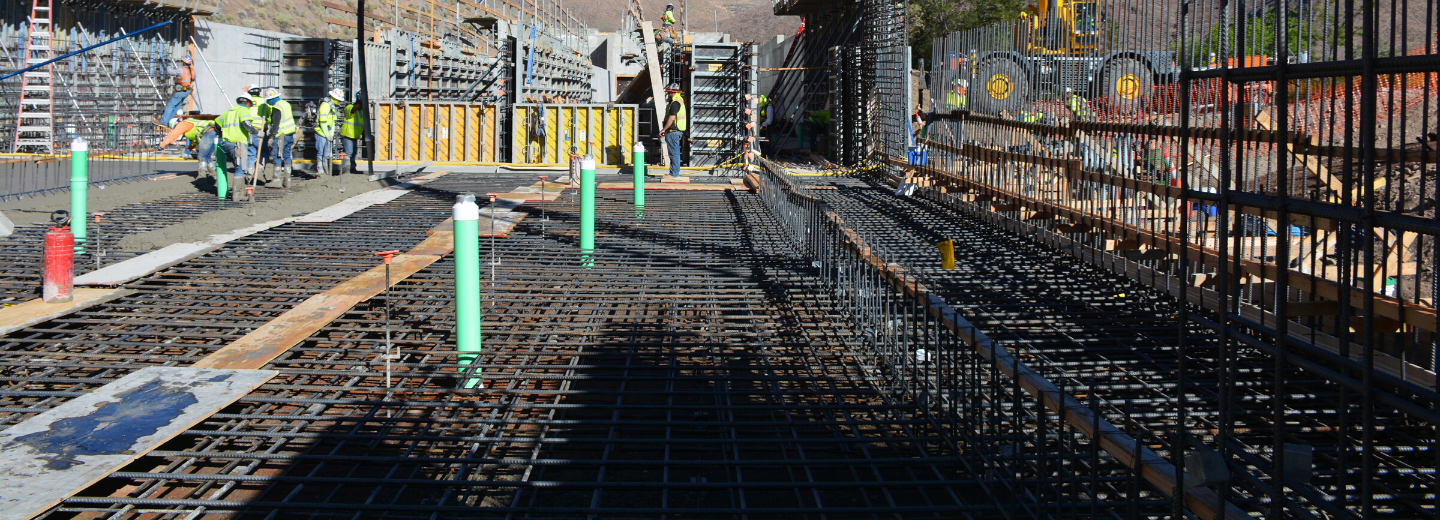Granite Construction, and its partners the Farmers Conservation Alliance (FCA) and the Bureau of Reclamation (Reclamation), celebrated a project milestone on Wednesday, May 27, 2020, at the Derby Dam fish screen project as crews completed the fish passage’s concrete floor.

Granite Celebrates Project Milestone with Final Floor Pour at Derby Dam Fish Screen
The screen is the final piece in a major fish passage project to restore habitat connectivity for native fish species. The overall project has three components (1) an upstream fish passage channel on the north side (River left bank) of Derby Dam that was completed in 2003, (2) automation of two Derby Dam River gates to maintain suitable fish passage channel water velocities which was completed in 2019, and (3) a screen on the Truckee Canal to allow for entrained fish to safely return to the Truckee River.
The Derby Dam fish screen is an addition to the historic Derby Dam, completed in 1905 and recognized as the first project of then newly formed U.S. Reclamation Service (now Bureau of Reclamation). Historically, fish ladders constructed and operated at the dam (1905-1941) were ineffective and periodically damaged by flooding.
The new fish screen will support safe fish passage along the Truckee River between Pyramid Lake and Lake Tahoe, promoting the recovery of the federally-listed, threatened Lahontan Cutthroat Trout Oncorhynchus clarkii henshawi (LCT), as well as fishing and recreation opportunities in Nevada. Lahontan Cutthroat Trout in the Truckee Basin were an important food source for Native Americans and were once so numerous that a robust commercial fishery existed. The last known historical Truckee River run of adfluvial LCT from Pyramid Lake was in 1938 and by 1944 they were considered extirpated due to overharvest, habitat degradation, and physical barriers preventing access to upstream spawning habitat. Since 1998, stocking of adfluvial LCT with genetics from the historical Pyramid Lake population has occurred by Federal and State agencies and Tribes, and annual LCT spawning runs are increasing.
Upon completion of the fish screen construction in the fall of 2020, the Derby Dam Fish Passage project will provide safe fish passage both upstream and downstream of the dam. This project will facilitate recovery of LCT in Pyramid Lake and the Truckee River, which has been a collaborative effort between multiple stakeholders and agencies. Reclamation and the U.S. Fish and Wildlife Service (USFWS) have partnered in the design and operation of the Derby Dam Fish Passage project. FCA’s horizontal plate fish screen was selected by Reclamation and Reclamation funded the screen construction.
“By pouring the last of the concrete floor, it allows crews to progress on placing interior walls and second stage concrete that is needed to begin the installation of the stainless-steel fish screens. We have been dealing with ground water from the start of construction and by having the slab completed, it eliminates the need for pumping and diverting water and provides crews a stable work platform. This brings us one step closer to finishing the structural concrete and completing an environmental infrastructure project that supports Nevada’s native fish habitat and our surrounding communities,” said Cody Cummings, Granite’s Project Manager for the Derby Dam Horizontal Fish Screen project.
To date, over 5,000 cubic yards of structural concrete have been poured in preparation to start installing patented fish screens, with an additional 1,500 yards to be poured for the final walls of the structure in the upcoming months.
Scheduled for completion in Fall 2020, the project will feature five fish screens to accommodate fish passage during variable flow rates of the Truckee River. The screen is designed to work with the diverted flow of water, providing fish protection by allowing fish and debris to move above and over the surface of the screen.
“Proper hydraulic flows are a critical component to the functionality of the fish screens, and it is imperative that the structural concrete work is completed within the tight tolerances of the project to ensure the hydraulic modeling is not altered. Adjusting hydraulic flows will require complex coordination between the gates that control the river, canal and fish screen flows to allow the system to operate properly. Upon completion, the screens will be able to divert fish safely back to the river while maintaining flows in the canal for irrigation purposes,” stated Cummings.
For more information on the Derby Dam Horizontal Fish Screen project, please visit https://fcasolutions.org/derby-dam/.
